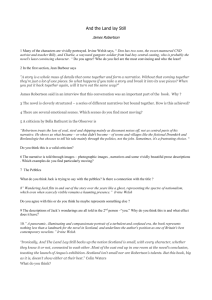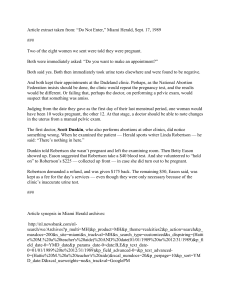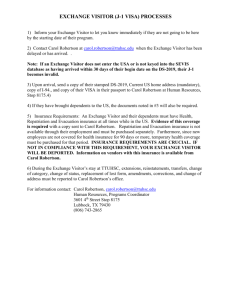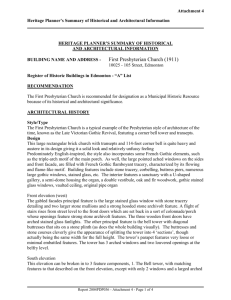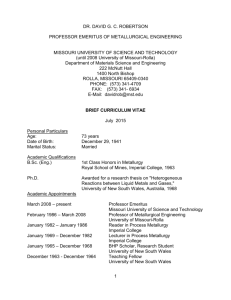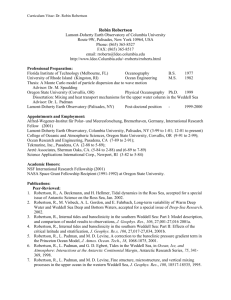heritage planner`s summary of historical and
advertisement
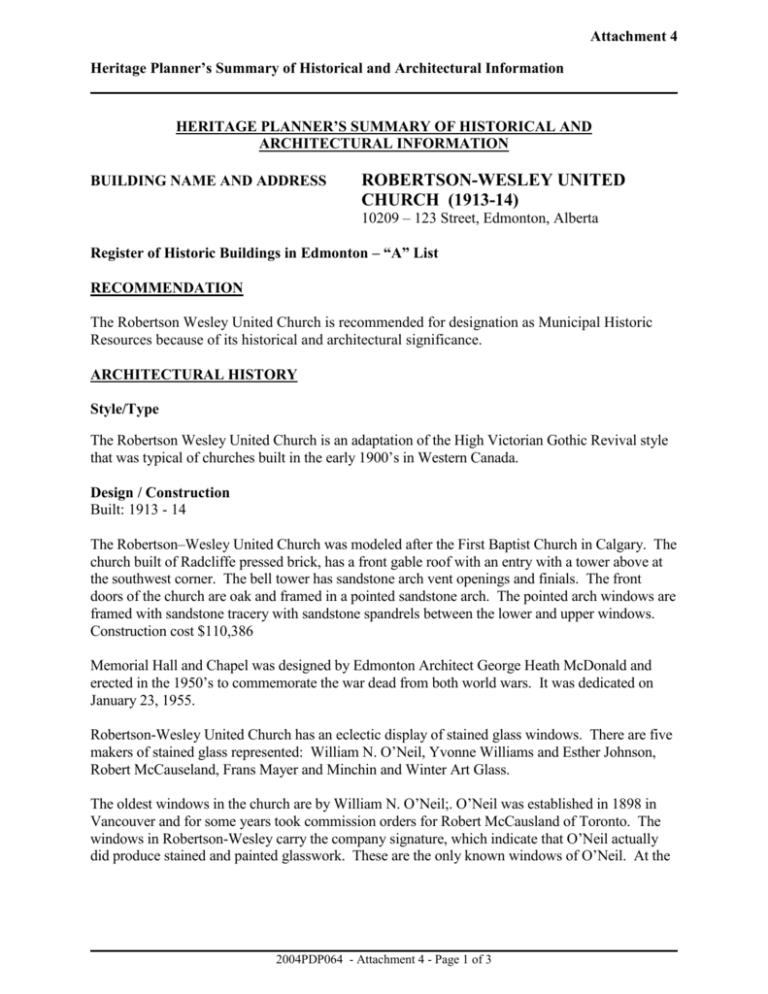
Attachment 4 Heritage Planner’s Summary of Historical and Architectural Information HERITAGE PLANNER’S SUMMARY OF HISTORICAL AND ARCHITECTURAL INFORMATION BUILDING NAME AND ADDRESS ROBERTSON-WESLEY UNITED CHURCH (1913-14) 10209 – 123 Street, Edmonton, Alberta Register of Historic Buildings in Edmonton – “A” List RECOMMENDATION The Robertson Wesley United Church is recommended for designation as Municipal Historic Resources because of its historical and architectural significance. ARCHITECTURAL HISTORY Style/Type The Robertson Wesley United Church is an adaptation of the High Victorian Gothic Revival style that was typical of churches built in the early 1900’s in Western Canada. Design / Construction Built: 1913 - 14 The Robertson–Wesley United Church was modeled after the First Baptist Church in Calgary. The church built of Radcliffe pressed brick, has a front gable roof with an entry with a tower above at the southwest corner. The bell tower has sandstone arch vent openings and finials. The front doors of the church are oak and framed in a pointed sandstone arch. The pointed arch windows are framed with sandstone tracery with sandstone spandrels between the lower and upper windows. Construction cost $110,386 Memorial Hall and Chapel was designed by Edmonton Architect George Heath McDonald and erected in the 1950’s to commemorate the war dead from both world wars. It was dedicated on January 23, 1955. Robertson-Wesley United Church has an eclectic display of stained glass windows. There are five makers of stained glass represented: William N. O’Neil, Yvonne Williams and Esther Johnson, Robert McCauseland, Frans Mayer and Minchin and Winter Art Glass. The oldest windows in the church are by William N. O’Neil;. O’Neil was established in 1898 in Vancouver and for some years took commission orders for Robert McCausland of Toronto. The windows in Robertson-Wesley carry the company signature, which indicate that O’Neil actually did produce stained and painted glasswork. These are the only known windows of O’Neil. At the 2004PDP064 - Attachment 4 - Page 1 of 3 Attachment 4 Heritage Planner’s Summary of Historical and Architectural Information opening of the Robertson Presbyterian Church on January 25, 1914, all the windows were of the style now seen in the East and West walls of the balcony and the South stairwells. The original larger lights depicted biblical scenes and were of the same quality as those remaining. The East window is the Good Shepherd and the West window is the Angel Gabriel, announcing to Mary that she will be the mother of the Messiah. The stained glass windows are also part of the organized tours during Historic Edmonton Week. Architect/Builder D. S. McIlroy (Architect of the First Baptist in Calgary) George Heath McDonald (Architect of Memorial Hall) CULTURAL HISTORY Historical Importance Robertson-Wesley United Church’s roots date back to early 1900’s when Edmonton was booming. A special meeting of the congregation of the First Presbyterian Church was called in 1908 to discuss church expansion. A committee was struck and recommended another congregation. Three lots were purchased on the northwest corner of Jasper and 116 Street. A church with a capacity for 400 was built. It was called Knox Church, but renamed Robertson in March 1910. A growing congregation led church elders to plan the present church. Two lots were purchased in 1912. With a loan of $50,000 construction began and the first permanent minister Reverend Rupert Stewart laid the cornerstone July 1st 1913. In 1925 Robertson joined the United Church of Canada – the union of Methodist and Presbyterian Churches. In 1971, Wesley United Church and Robertson merged. Wesley’s memorial windows were installed in Robertson and its building at 102 Avenue and 117 Street was sold to become the Canadian Native Friendship Centre. James Robertson, (1839-1902) Born in the Scottish Highlands, the family immigrated to East Oxford, Ontario. After graduating 1869 from the Union Seminary in New York he began preaching at Knox Presbyterian Church in Winnipeg from 1870 to 1875. He then became the Superintendent of Mission of the Presbyterian Church in the West and Northwest. In the six years he was Superintendent (1881-1887) he had increased the number of mission stations from 129 to 389, a growth of 260, one for every week of those six years. In 1895 he became the Moderator of the Presbyterian Church. 2004PDP064 - Attachment 4 - Page 2 of 3 Attachment 4 Heritage Planner’s Summary of Historical and Architectural Information CONTEXT Site This is the second site for the Robertson-Wesley United Church. The first site was located on Jasper Avenue and 116 Street. Neighbourhood The Robertson-Wesley United Church is located in the Oliver neighourhood and is adjacent to the 124 Street/High Street. Commercial area to the west. On the east, it is adjacent to medium to high density residential area. Visual/Symbolic The Robertson-Wesley United Church contributes to the neighbourhood as a church and of course as a landmark. Architecturally, it is visually striking and impressive. It is open every year for tours during Historic Edmonton Week. INTEGRITY Both the original Robertson–Wesley United Church and the 1950s addition of Memorial Hall and Chapel is largely altered. Any changes or alterations that occurred over the years have been done with sensitivity and respect to the original. 2004PDP064 - Attachment 4 - Page 3 of 3
